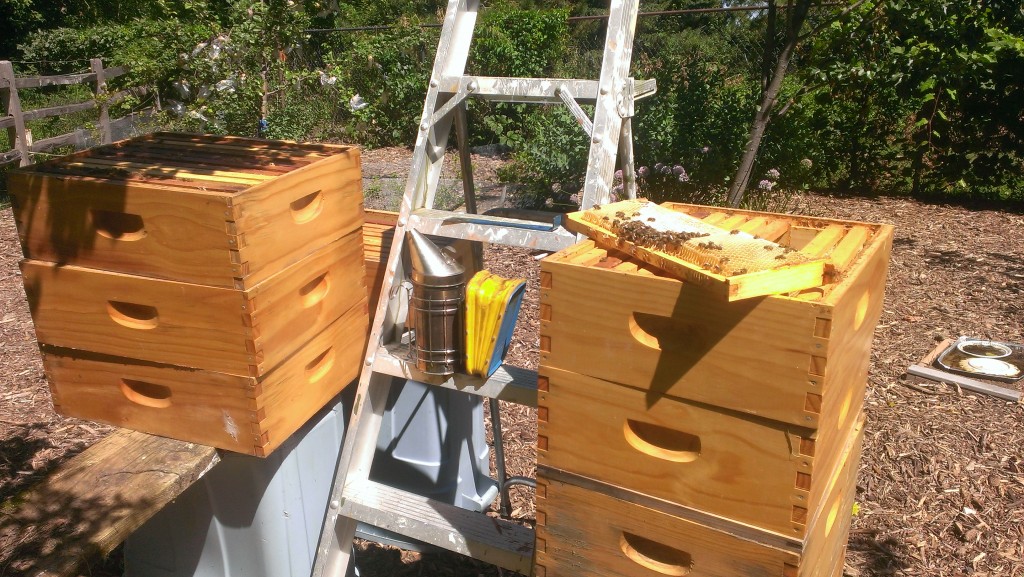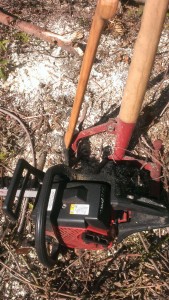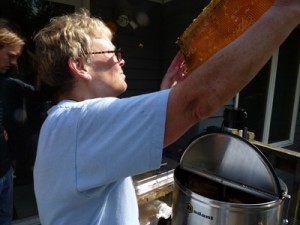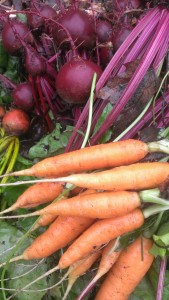Lughnasa State Fair Moon
Oh. My. Just came back from a wrestling match with an angry superorganism. Bill 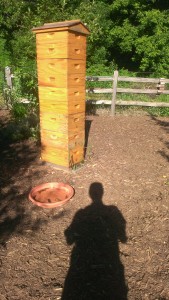 Schmidt noticed the height of my tower ‘a honey and wondered about wind knocking it over, but the height produces another kind of problem as well. A happy problem in the end, but a sweat inducing, sting evoking problem in the here and now.
Schmidt noticed the height of my tower ‘a honey and wondered about wind knocking it over, but the height produces another kind of problem as well. A happy problem in the end, but a sweat inducing, sting evoking problem in the here and now.
Out of 6 honey supers on top of the three hive boxes, four are full. Honey, basically water, weighs more than 8.5 pounds per gallon. Each of these full supers weighs in close to 50 pounds. Therein the happy and the sad of it.
The happy is 200 pounds of honey! The sad is lifting 200 pounds of honey! Plus some.
Here’s the deal. The recommendation is to treat for mites and to do it now in August, with the honey supers on. That means using a food grade miticide, one that won’t harm the honey in any way. Which means less potent. Which is good as far as I’m concerned. The idea is that we rid the colony of mites in August, then the brood turns over after the nectar flow and produces mite free bees for overwintering. Mites reduce the bees capacity to overwinter. By a lot.
So. O.K. I decided yes. I’ll do that. When I went to buy the one treatment and done 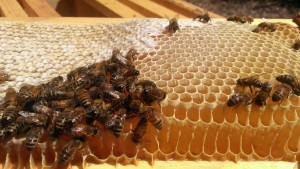 product, miteaway, my dealer was out. He had instead hopguard. Hopguard requires two strips in each of three hiveboxes (the big ones on the bottom that hold the colony and its honey stores for the winter). That’s one week’s treatment and the full treatment requires three weeks.
product, miteaway, my dealer was out. He had instead hopguard. Hopguard requires two strips in each of three hiveboxes (the big ones on the bottom that hold the colony and its honey stores for the winter). That’s one week’s treatment and the full treatment requires three weeks.
(taken today and the point of all this hooha)
Now we get to the problem. Each of those honey supers has to come off and sit somewhere while I put the hopguard strips in the hiveboxes. So, that’s 200+ pounds off and set aside. It also means moving two of the three hiveboxes off and back on. They weigh substantially more than a full honey super.
Thanks to the Canadian leakage as Paul Douglas calls it the weather is about as good as it’s reasonable to expect: 70 degrees with a dewpoint of 50. But. By the time I finished schlepping honey supers the sweat had begun to run. Down into my eyes.
Physically moving these boxes is right at or a bit more than I can do easily. That’s ok, for 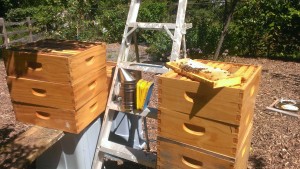 the most part, but it does mean that I can’t make the slow, deliberate motions that keep the bees calm. So, by the time I got to the hiveboxes I couldn’t see out of one eye and had to squat and lift with my legs to budge them. I’m not even going to mention the slippery hopguard strips that would not slide easily between the frames.
the most part, but it does mean that I can’t make the slow, deliberate motions that keep the bees calm. So, by the time I got to the hiveboxes I couldn’t see out of one eye and had to squat and lift with my legs to budge them. I’m not even going to mention the slippery hopguard strips that would not slide easily between the frames.
(an improvised super holding device. also taken today)
Anyhow, I got all that done, got the honey supers back on and was feeling good. Until I saw the queen excluder resting on the hiveboxes. The queen excluder goes between the hiveboxes and the honey supers to prevent the queen from laying eggs in the supers. Oh. My. You can insert here words you use when you realize you have shot yourself in your own foot.
That’s right. I now had to remove the supers a second time, put on the queen excluder and put them all back on again. Well, that’s all done and finished until next Wednesday. When I do it all over again. Except, I hope, for that queen excluder part.
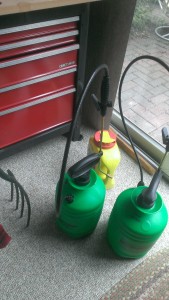 (vegetative) and Brix Blaster (reproductive) solutions and hit the garden well before 8 am. There’s apparently something about plant physiology that makes between 4 am and 8 am the optimal time to spray. The probability of me doing anything at 4 am is not high so I always run closer to 8.
(vegetative) and Brix Blaster (reproductive) solutions and hit the garden well before 8 am. There’s apparently something about plant physiology that makes between 4 am and 8 am the optimal time to spray. The probability of me doing anything at 4 am is not high so I always run closer to 8.

